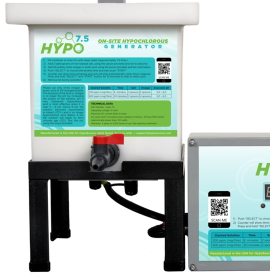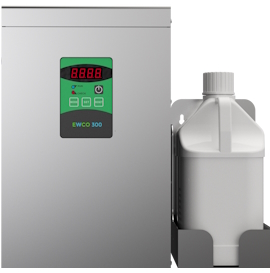अनुसंधान > उद्यम > Food > प्रयोग : Biofilm
हाइपोक्लोरस तेज़ाब के घोल के सामान्य नाम
- Electrolytically Generated Hypochlorous Acid
- Neutral Electrolyzed Water (NEW)
- Electrolyzed Oxidizing Water (EOW)
- Electro-chemically Activated Water (ECA)
- Super-oxidized water (SOW)
परिणाम : 6 प्रकाशित लेख

Microbe(s): Total Microbial Count
Product decontamination is one of the most important processes of the hygienic practice in food industries such as Minimally Processed Vegetables (MPV) plants and sodium hypochlorite (NaOCl) solutions are commonly used as a biocide for disinfection. Although it may be corrosive and irritating when compared to , reducing the free chlorine concentration needed to sanitize salads, also decreasing water consumption whilst taking into account environmental and food quality impacts.

Microbe(s): Pseudomonas aeruginosa, Enterococcus faecalis, Micrococcus luteus
In the dairy industry, cleaning and disinfection of surfaces are important issues and development of innovative strategies may improve food safety. This study was aimed to optimize the combined effect of alkaline electrolyzed water (AEW) and neutral electrolyzed water (NEW) as s were significantly affected by surface roughness electropolished SSP required 10 min, 100 mg/L AEW at 30 C, whereas SSP without modification required 30 min, 300 mg/L AEW at 30 C. From confirmatory tests cells removed were 3.90 0.25 log CFU/cm2 for electropolished SSP, and 3.20 0.20 log CFU/cm2 for SSP without modification. NEW is non-corrosive, and can be advantageously used for environmentally friendly cleaning and disinfection processes.

Microbe(s): Listeria monocytogenes
The presence of Listeria monocytogenes in food processing environment is a risk of food contamination by persistent cells due to their ability to attach to stainless steel and other surfaces. We aimed to study biofilms formation of lux-tagged L. monocytogenes EGDe on stainless steel surfaces and their control using neutral electrolyzed water (NEW), where biofilms development was monitored using destructive and non-destructive microscopy techniques. The development of biofilms was monitored for 5 days on stainless steel chips. We used two sources of NEW, commercial (NEW-1) and from a prototype (NEW-2) for treatments of free and biofilm L. monocytogenes EGDe cells. Complete inhibition of L. monocytogenes EGDe free cells was observed after 1 min contact time for both NEW sources, but NEW-1 concentration used (9 mg/L total available chlorine, TAC) was 1.8 times higher. Cells within biofilms were more resistant to NEW compared to planktonic cells. Same concentration of both NEW sources (70 mg/L TAC) exhibited complete inhibition of biofilm cells after 3 min contact time. However, using a sub-lethal dose of 40 mg/L TAC, NEW-2 reduced about 2 log CFU/cm2 biofilm cells while NEW-1 inhibited 0.3 log CFU/cm2 only. Biofilms formation and antagonistic effect of NEW could be visualized by epifluorescence and scanning electron microscopy, revealing significant biofilms structure. The disinfectant effect of NEW may be attributed to the combined antimicrobial effect of available chlorine and high ORP exhibited by its oxidizing compounds. NEW does not promote metal equipment corrosion due to its neutral pH, and is also environmentally friendly.

Microbe(s): Listeria monocytogenes
All food processing surfaces are potential sites for biofilm formation of foodborne pathogens, which may result in increased virulence and better adaptation to survival in foods. This study was aimed to evaluate the effect of two antimicrobials, neutral electrolyzed water (NEW) and nisin, and their combination, on Listeria monocytogenes Scott A biofilms formed on glass and stainless steel surfaces. We also examined the effects of sub-lethal doses of NEW on listeriolysin O (LLO) activity from free and biofilm listerial cells. Coupons inoculated with L. monocytogenes cells were used to produce biofilms by incubation for four days at 37 C. An orthogonal experimental design with two replicates was used to test the effect of four factors on biofilm population. The factors were antimicrobial agents: NEW (65 ppm), nisin (6976 IU/per coupon), and their combination; temperature: 20 C and 37 C; contact time: 5, 10, 20 and 45 min; and type of material: glass or stainless steel. Antimicrobial compounds and exposure time significantly affected L. monocytogenes populations in biofilms from both surfaces. A bactericidal effect was shown by NEW on free listerial cells at 30 ppm for 0.5 min of exposure, regardless treatment temperature. Same effect was observed on listerial biofilms at 65 ppm or higher concentrations, after 10 min contact time. A sub-lethal concentration of NEW acting on listerial biofilms resulted in an increased LLO activity, while non-treated biofilms exhibited a reduced activity, but higher than that found for free cells. The use of NEW as a sanitizer may be effective in reducing bacterial contamination. In addition because of its safety, which would benefit the food industry and its environmental friendliness, NEW may be of significant use in the food industry.

Microbe(s): Listeria monocytogenes, Flavobacterium spp.
Aims: To determine the effect of chlorine on mixed bacterial biofilms on stainless steel (SS) and conveyor belt surfaces. Methods and Results: Biofilms were exposed to pH-adjusted (6.5) and non-pH-adjusted solutions of chlorine (200, 400 and 600 ppm) for either 2, 10 or 20 min and survivors enumerated. There were significant differences in cell death relating to chlorine concentration and exposure time for the cells attached to the SS, with solutions adjusted to pH 6.5 being more effective at reducing numbers. In contrast, on conveyor belt surfaces cell numbers decreased by less than two logs after 20 min regardless of treatment. Conclusions: Chlorine effectiveness is dependent on its concentration, solution pH, exposure time, the nature of the surface and the microbial species present. Significance and Impact of Study: In the interests of food safety it is important that sanitizer users are aware of the conditions that effect their performance.

Microbe(s): Listeria monocytogenes
This study investigates the resistance of Listeria monocytogenes biofilms on stainless steel surfaces to electrolyzed oxidizing (EO) water. A direct agar overlay method was used to estimate the attached bacteria on stainless steel coupons after an EO water treatment. A scraping method was also used to quantify the adherent cell populations after the EO water treatment. The stainless steel surface allowed 10 to 15% of the surface area to be covered by Listeria biofilm when the inoculated stainless steel coupon was incubated in 10% tryptic soy broth (TSB) at 23C for 48 h. When the stainless steel coupons containing adherent cells were treated with EO water (56 mg/L of residual chlorine) for 10, 30, 60, 180, and 300 s, adherent cell populations (10.3 log10 CFU/coupon) were reduced with increasing treatment time. Although the direct agar overlay methods do not quantify survival of single bacteria, only one to five cell clumps per coupon survived after 300 s of the EO water treatment. Using the scraping method, the adherent cell population on the stainless steel coupons was reduced by about 9 log cycles after 300 s of EO water treatment.
Best Hypochlorous Acid (HOCL) Generators
 Portable Hypochlorous Acid (HOCL) Machine
Portable Hypochlorous Acid (HOCL) Machine
Make high quality hypochlorous acid in the home or office.
$169.99 + Free Shipping
 HOCL Machine + Electrostatic Sprayer
HOCL Machine + Electrostatic Sprayer
Make hypochlorous acid and spray with an electrostatic cold fogger.
$319.98 + Free Shipping


